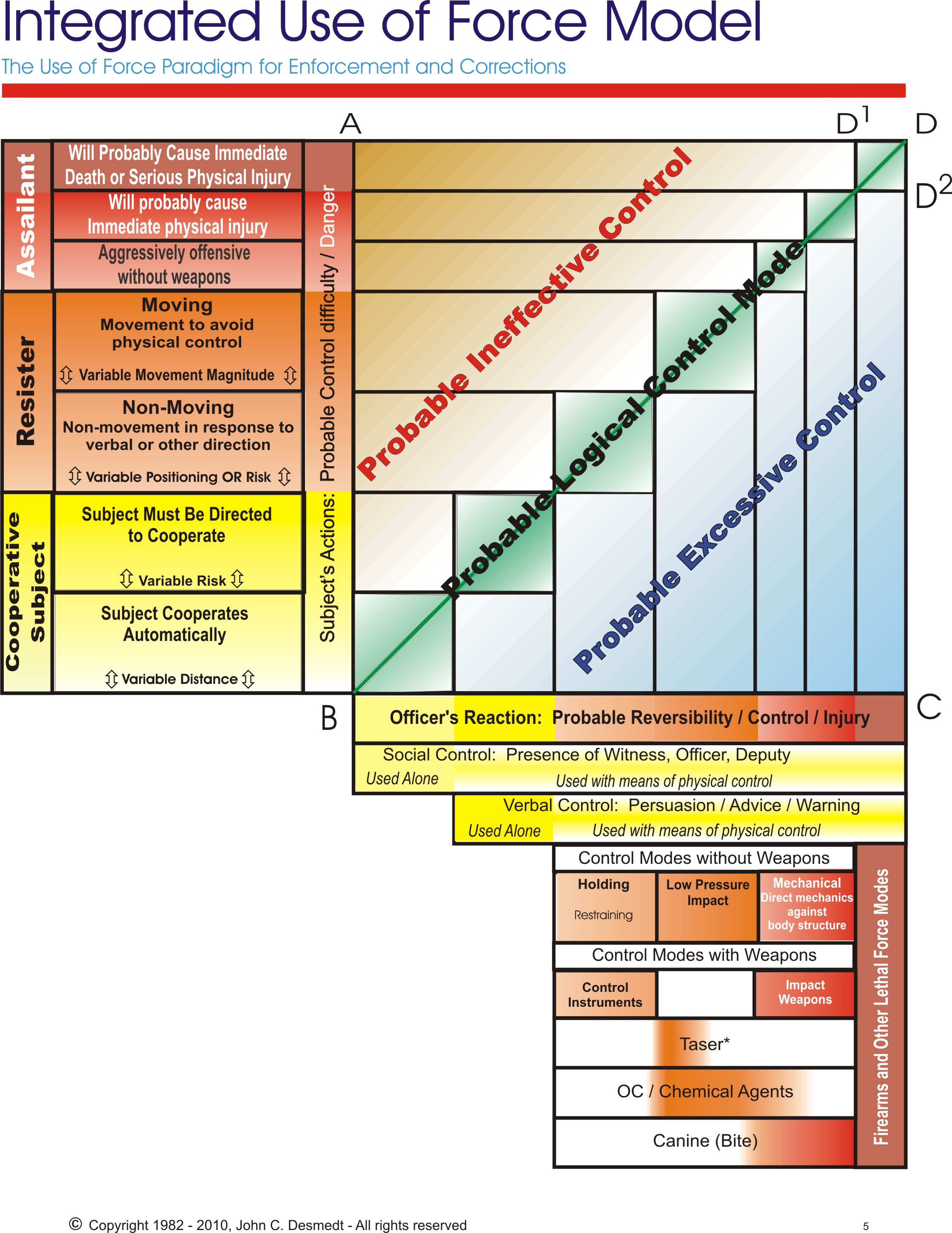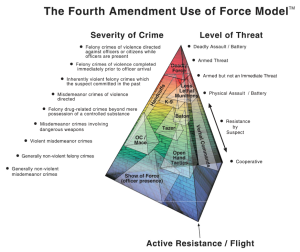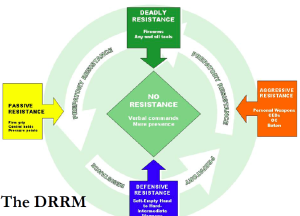How much force can police use?
The first answer to that question probably ought to be another question, “Under what circumstances?”
For example, if someone’s passively resisting – just goes limp, doesn’t fight back – should a police officer whip out his issue sidearm and kill them? Perhaps if the officer is a member of the Chicago Police Department (where apparently officers can get away with anything) but in a normal police department, such behavior will get you fired and criminally charged.
Is this okay?
It shouldn’t come as any great shock that there’s a whole lot of thinking, philosophizing, and seminaring that goes into making these decisions. You might say that there’s kind of a cottage industry based on formulating “response to resistance” or the “use of force continuum”.
Wikipedia has a decent example model of a “use of force continuum”, going from “Cheez it, Ma, the cops are here” to lethal force. This is an actual model the Los Angeles Police Department used in 1978:
I think this is a nice simple visualization of another model:
You might call these “linear” models. A guy named Chris Butler wrote a pretty good paper about the various models. If things were simple enough that the linear models worked, there wouldn’t be an industry in this, right? One of Butler’s points is:
I’m not sure I get that whole “a strict application of a stepped or linear progression of force fails completely”. Did anyone actually do that? I mean, I’m not a trained police officer, but if I’m trying to arrest some guy and the situation goes from limp passive resistance to “pulls a gun out of his waistband”, I personally am going straight to “bust a cap in his ass” and bypassing all the in-between steps in the linear progression model.
Here’s another model they showed us in our CPA class:
“…so complex that police officers found them difficult to understand even in a non-stress environment…”
I think this model is very similar, if not identical to, another one they showed us in class:
To quote our guest lecturer, “I think if you stare at this long enough, and turn the circles back and forth, it eventually spells out ‘Drink your Ovaltine’.”
And if you think those are questionable, there’s actually a 3-D pyramid model (with smaller pyramids inside it, even): I haven’t been able to find an illustration of that one online, but trust me, it will make your head hurt. (But! It will also keep your razor blades sharp!)
Edited to add 4/1/2016: I managed to find the 3-D pyramid model, which is also known as “The Fourth Amendment Use of Force Model™”. I believe this is the intellectual property of Luis Robles, Esq., of the Robles, Rael & Anaya, P.C. law firm.
I think my use of it here constitutes “fair use” for the purposes of commentary and criticism. I am linking this image to the source where I found it, which appears to be a paper by the Honorable Mr. Robles also titled “The Fourth Amendment Use of Force Model”. The original version of this image appears on page 30.
What model does the Austin Police Department use? Here’s a PowerPoint I found on the city’s website: this contains some of the same content that was in our CPA presentation. I’m going to pull one illustration out, from page 10:
This seems to me to be a fairly simple model, and one I believe I could live with if I was an APD officer. Slides 15-21 give definitions for each of the categories, but I’ll give quick summaries them here:
- “No resistance”: basically, “Whatever you say, officer.”
Only a law enforcement officer’s presence and verbal commands are required when dealing with these individuals; no coercive physical contact is necessary.
- “Passively Resistant”: doesn’t follow orders, isn’t physically threatening, but “may be verbally questioning or disagreeing.”
Appropriate responses include using a firm grip, control holds, and pressure points to obtain compliance.
- “Defensive Resistance”: trying to evade the officer’s control, such as pulling out of the officer’s grip or taking other physical actions.
Justified responses may include soft-empty hand techniques as well as the use of personal weapons (hands, fists, feet), batons, pepper spray, and CEDs.
(A CED is a “Conducted Energy Device”: for example, a Taser.)
- “Aggressive Resistant”: taking “offensive action by attempting to push, throw, strike, tackle, or physically harm the officer or another person.”
- “Deadly Resistant”: the suspect is using, or attempting to use, a level of force that could cause death or “serious injury” to the officer or another person.
- Then there’s something called “Prepatory Resistant”:
Although on the surface a suspect may exhibit signs accorded “passive resistant” by the DRRM, or another level of resistance less than deadly, the officer may recognize that the suspect is preparing to offer greater resistance or launch an attack through behavioral cues (verbal, non-verbal and/or physical). The officer must be prepared to adjust tactics for such a change or attack.
The way I read that, it is less a step on the continuum and more of a “watch for these signs, and if the guy tenses up or acts like he’s going to run, be prepared to move to the next step”.
There’s also the APD Policy Manual: section 200, specifically, discusses use of force polices and the required reporting if force is used.
So what are the answers to the questions I asked above?
In the case of the UC Davis protesters, I asked our lecturer about that specifically. His response was: if you watch the entire video, the protesters who were sprayed were blocking the path of officers who had taken other protesters into custody. According to our lecturer, that escalated the situation from “Passively Resistant” to “Defensive Resistance”: and, per APD policy, “Defensive Resistance” can be met with the use of pepper spray. Something about that bothers me, but I can’t quite put my finger on it.
Pepper-spraying the guy in the back of the van? Well, that just happened a few days ago: the APD investigation is ongoing, and we haven’t seen all the video, and and and…
As for the shooting, we found out today: that will get you fired.





[…] Earlier this week, I wrote about the Austin Police Department, use of force policies, and the officer who was fired for shooting a naked … […]
[…] it fell off the front page, I wanted to also note here that I updated the “Use of force” post: now with […]